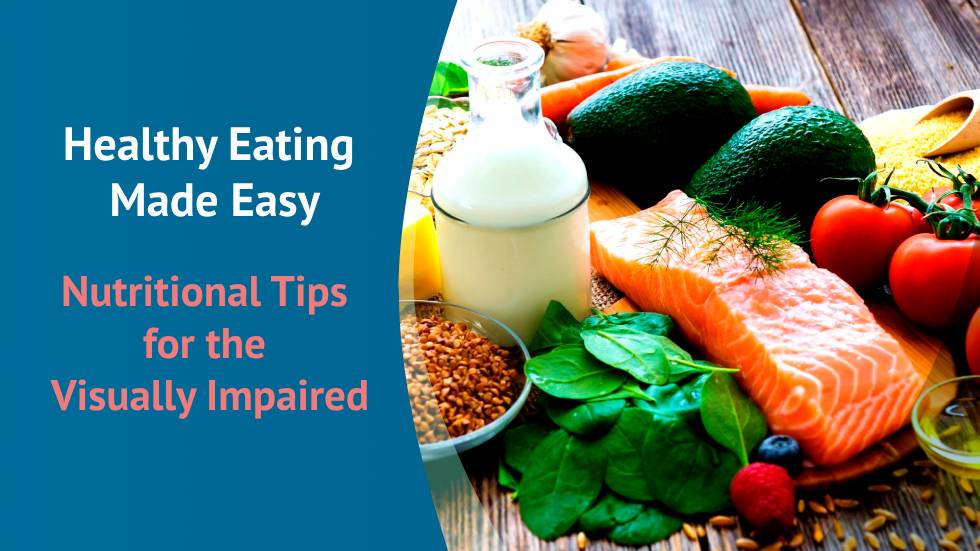
Maintaining a balanced diet is crucial for overall health, and this is true for everyone, including those who are visually impaired. Although navigating the world of nutrition without sight presents unique challenges, it is entirely possible to eat healthily with the right strategies and tools. This blog explores practical nutritional tips tailored for visually impaired individuals to help them make informed and healthy food choices.
1. Understanding Nutritional Needs
A well-balanced diet provides essential nutrients that support overall health and well-being. Key components of a nutritious diet include:
- Proteins: Important for muscle repair and growth. Sources include meat, poultry, fish, eggs, beans, and nuts.
- Carbohydrates: Provide energy. Opt for whole grains, fruits, and vegetables.
- Fats: Essential for brain health and energy. Focus on healthy fats from avocados, nuts, and olive oil.
- Vitamins and Minerals: Vital for various bodily functions. Include a variety of fruits and vegetables to ensure adequate intake.
2. Adaptive Cooking Techniques
Cooking without sight requires adaptations to ensure safety and effectiveness. Here are some tips for adaptive cooking:
- Use Assistive Technology: Tools like talking kitchen scales, braille labels, and tactile markers can make cooking easier. For example, talking timers can help keep track of cooking times.
- Organize Your Kitchen: Keep frequently used items in consistent, accessible locations. Use tactile labels or organizers to identify different foods and utensils.
- Safety First: Use tools with non-slip grips and kitchen gadgets designed for safety, like automatic can openers and cutting boards with stabilizing features.
3. Meal Planning and Preparation
Effective meal planning can help ensure a balanced diet and simplify grocery shopping:
- Create a Meal Plan: Plan your meals for the week, including breakfast, lunch, dinner, and snacks. This can help you make healthier choices and avoid last-minute unhealthy options.
- Use a Shopping List: A tactile or audio shopping list can assist with grocery shopping. Organize your list by food categories to streamline your shopping experience.
- Batch Cooking: Prepare and store meals in advance to save time and ensure you have nutritious options readily available.
4. Labeling and Identifying Foods
Properly labeling and identifying foods can help you make informed choices:
- Braille and Tactile Labels: Use braille or tactile labels on food containers and pantry items to easily identify them. You can also use rubber bands or color-coded stickers for quick recognition.
- Organize by Category: Store similar items together, such as grains, proteins, and vegetables. This makes it easier to locate and choose ingredients.
5. Healthy Eating Strategies
Implementing healthy eating strategies can help you maintain a balanced diet:
- Portion Control: Use measuring cups with tactile markings to manage portion sizes. This can help prevent overeating and ensure balanced meals.
- Hydration: Keep track of your water intake by setting reminders or using a talking water bottle to stay hydrated throughout the day.
- Snacking Wisely: Choose healthy snacks like fruits, nuts, and yogurt. Prepare snack-sized portions in advance for convenience.
6. Navigating Dining Out
Dining out can be enjoyable and inclusive with some planning:
- Review Menus in Advance: Many restaurants offer accessible menus online or can provide braille or large print menus upon request. Contacting the restaurant ahead of time can help you plan your meal.
- Ask for Assistance: Don’t hesitate to ask restaurant staff for help with reading the menu or identifying dishes. Most staff are happy to assist and accommodate dietary needs.
- Choose Healthy Options: Opt for dishes that are baked, grilled, or steamed rather than fried. Request dressings and sauces on the side to control added calories and fats.
7. Nutritional Resources and Support
Several resources and organizations provide support for visually impaired individuals looking to maintain a healthy diet:
- Accessible Cookbooks: Look for cookbooks available in braille, large print, or audio formats. Many organizations offer these resources to help with meal preparation.
- Nutritionists and Dietitians: Consult with a nutritionist or dietitian who specializes in working with visually impaired individuals. They can offer personalized advice and meal plans.
- Support Groups: Join online or local support groups where you can share tips, recipes, and strategies with others who have similar dietary needs.
Conclusion
Eating healthily without sight is entirely achievable with the right strategies and tools. By adopting adaptive cooking techniques, using assistive technology, and implementing effective meal planning and identification methods, visually impaired individuals can maintain a balanced diet and enjoy a variety of nutritious foods. Embracing these practices not only supports physical health but also enhances overall well-being and independence.
With thoughtful planning and the right resources, the journey to healthy eating becomes more accessible and enjoyable, paving the way for a fulfilling and nutritious lifestyle.





